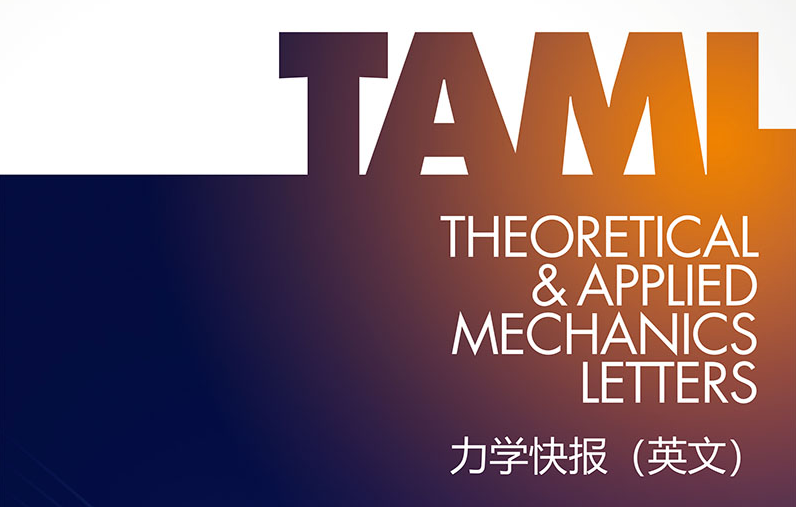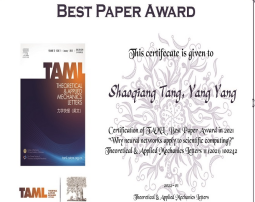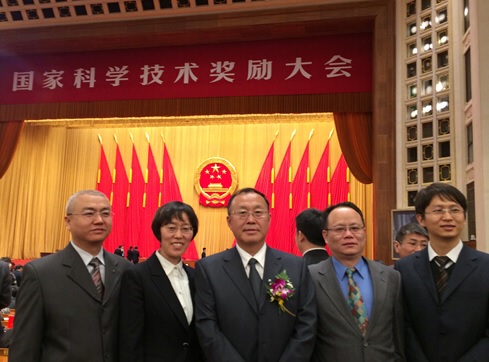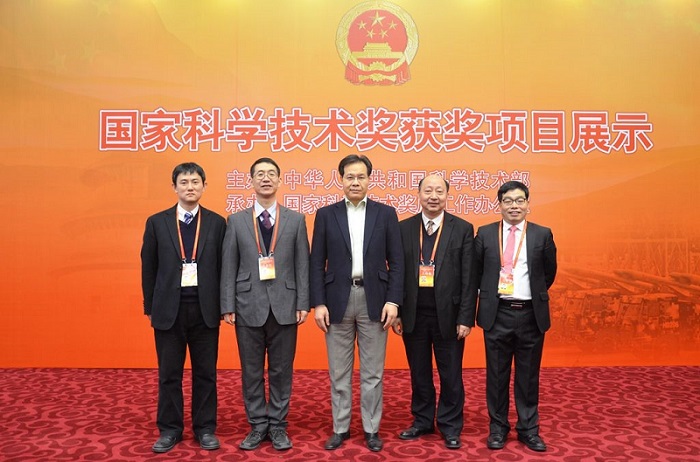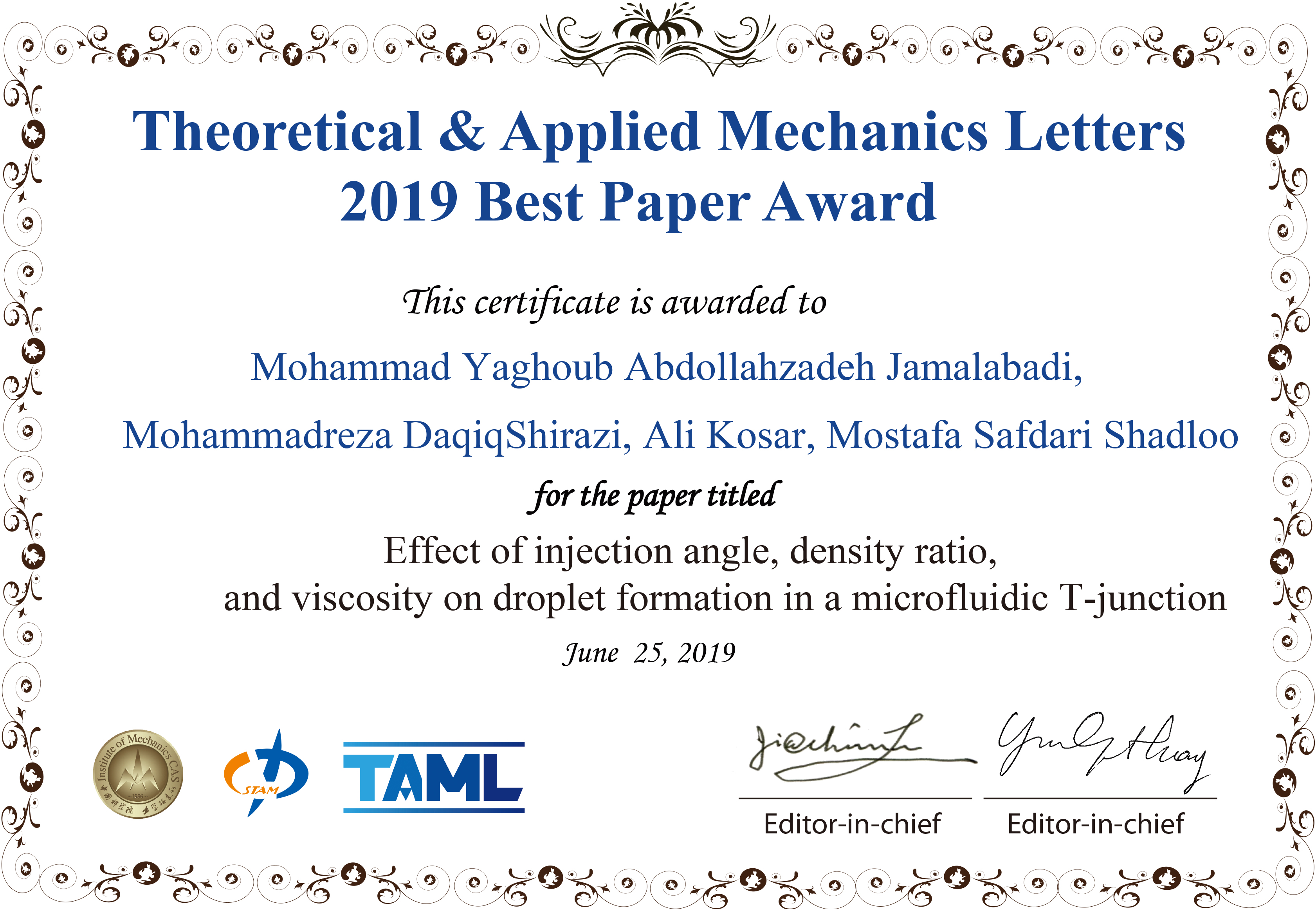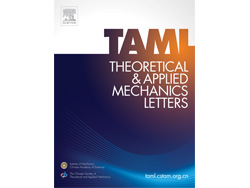Institute of Mechanics,
Chinese Academy of Sciences
2014 Vol.4(6)
Display Mode: |
Theoretical and Applied Mechanics Letters 2014, 4(6): 061001.
doi: 10.1063/2.1406101
Abstract:
A hybrid numerical-experimental approach to identify elastic modulus of a textile composite panel using vibration test data is proposed and investigated. Homogenization method is adopted to predict the initial values of elastic parameters of the composite, and parameter identification is transformed to an optimization problem in which the objective function is the minimization of the discrepancies between the experimental and numerical modal data. Case study is conducted employing a woven fabric reinforced composite panel. Three parameters (E11, E22, G12) with higher sensitivities are selected to be identified. It is shown that the elastic parameters can be accurately identified from experimental modal data.
A hybrid numerical-experimental approach to identify elastic modulus of a textile composite panel using vibration test data is proposed and investigated. Homogenization method is adopted to predict the initial values of elastic parameters of the composite, and parameter identification is transformed to an optimization problem in which the objective function is the minimization of the discrepancies between the experimental and numerical modal data. Case study is conducted employing a woven fabric reinforced composite panel. Three parameters (E11, E22, G12) with higher sensitivities are selected to be identified. It is shown that the elastic parameters can be accurately identified from experimental modal data.
Theoretical and Applied Mechanics Letters 2014, 4(6): 061002.
doi: 10.1063/2.1406102
Abstract:
This work aims at evaluating the mechanical behavior of sisal fiber reinforced cement mortar. The composite material was produced from a mixture of sand, cement and water. Sisal fibers were added to the mixture in different lengths. Mechanical characterization of both the composite and the plain mortar was carried out using three point bend, compression, and impact tests. Specimens containing notches of different root radii were loaded in three point bending in an effort to determine the effect of the fibers on the fracture toughness of the material. The results obtained indicate that, while fiber reinforcement leads to a decrease in compressive strength, J-integral calculations at maximum load for the different notch root radii have indicated, particularly for the case of long fibers, a significant superiority of the reinforced material in comparison with the plain cement mortar, in consistence with the impact test data.
This work aims at evaluating the mechanical behavior of sisal fiber reinforced cement mortar. The composite material was produced from a mixture of sand, cement and water. Sisal fibers were added to the mixture in different lengths. Mechanical characterization of both the composite and the plain mortar was carried out using three point bend, compression, and impact tests. Specimens containing notches of different root radii were loaded in three point bending in an effort to determine the effect of the fibers on the fracture toughness of the material. The results obtained indicate that, while fiber reinforcement leads to a decrease in compressive strength, J-integral calculations at maximum load for the different notch root radii have indicated, particularly for the case of long fibers, a significant superiority of the reinforced material in comparison with the plain cement mortar, in consistence with the impact test data.
Theoretical and Applied Mechanics Letters 2014, 4(6): 062001.
doi: 10.1063/2.1406201
Abstract:
A concept of phase synchronization point is proposed, and then a model is built using this concept to explain secondary instabilities. This model has been used to determine the conditions of K-and H-type secondary instabilities, which are coincident with the conditions published in literatures. It also can be used to analyze other secondary instability phenomena. For example, the numerical results validate the analysis results in the case of 1/3rd subharmonic mode secondary instability. Furthermore, the numerical results indicate that the spanwise wave number of 3D disturbance has significant effect on the secondary instability.
A concept of phase synchronization point is proposed, and then a model is built using this concept to explain secondary instabilities. This model has been used to determine the conditions of K-and H-type secondary instabilities, which are coincident with the conditions published in literatures. It also can be used to analyze other secondary instability phenomena. For example, the numerical results validate the analysis results in the case of 1/3rd subharmonic mode secondary instability. Furthermore, the numerical results indicate that the spanwise wave number of 3D disturbance has significant effect on the secondary instability.
Theoretical and Applied Mechanics Letters 2014, 4(6): 062002.
doi: 10.1063/2.1406202
Abstract:
This paper presents a meso-level simulation of gas hydrate dissociation in low-permeability marine sediments. Interstitial pores are defined to describe fluid flow and particle movement. The proposed model couples multiphase fluid flow with particle movement to simulate the thermodynamics of gas hydrate dissociation triggered by sharp temperature rises. Hydrates respond quickly to temperature rise in low-permeability sediments. Dissociation causes pore pressure to rise rapidly to equilibrium then steadily increase above equilibrium pressure. Lower permeability sediment builds up greater excess pore pressure as the dissipation of pore pressure is constrained.
This paper presents a meso-level simulation of gas hydrate dissociation in low-permeability marine sediments. Interstitial pores are defined to describe fluid flow and particle movement. The proposed model couples multiphase fluid flow with particle movement to simulate the thermodynamics of gas hydrate dissociation triggered by sharp temperature rises. Hydrates respond quickly to temperature rise in low-permeability sediments. Dissociation causes pore pressure to rise rapidly to equilibrium then steadily increase above equilibrium pressure. Lower permeability sediment builds up greater excess pore pressure as the dissipation of pore pressure is constrained.
Theoretical and Applied Mechanics Letters 2014, 4(6): 062003.
doi: 10.1063/2.1406203
Abstract:
We use a potential flow solver to investigate the aerodynamic aspects of flapping flights in enclosed spaces. The enclosure effects are simulated by the method of images. Our study complements previous aerodynamic analyses which considered only the near-ground flight. The present results show that flying in the proximity of an enclosure affects the aerodynamic performance of flapping wings in terms of lift and thrust generation and power consumption. It leads to higher flight efficiency and more than 5% increase of the generation of lift and thrust.
We use a potential flow solver to investigate the aerodynamic aspects of flapping flights in enclosed spaces. The enclosure effects are simulated by the method of images. Our study complements previous aerodynamic analyses which considered only the near-ground flight. The present results show that flying in the proximity of an enclosure affects the aerodynamic performance of flapping wings in terms of lift and thrust generation and power consumption. It leads to higher flight efficiency and more than 5% increase of the generation of lift and thrust.
Theoretical and Applied Mechanics Letters 2014, 4(6): 062005.
doi: 10.1063/2.1406205
Abstract:
Stabilities of supersonic jets are examined with different velocity, momentum thickness, and core temperature. Amplification rates of instability waves at inlet are evaluated by linear stability theory (LST). It is found that increased velocity and core temperature would increase amplification rates substantially and such influence varies for different azimuthal wavenumbers. The most unstable modes in thin momentum thickness cases usually have higher frequency and azimuthal wavenumber. Mode switching is observed for low azimuthal wavenumbers, but it appears merely in high velocity cases. In addition, the results provided by linear parabolized stability equations show that the mean-flow divergence affects the spatial evolution of instability waves greatly. The most amplified instability waves globally are sometimes found to be different from that given by LST.
Stabilities of supersonic jets are examined with different velocity, momentum thickness, and core temperature. Amplification rates of instability waves at inlet are evaluated by linear stability theory (LST). It is found that increased velocity and core temperature would increase amplification rates substantially and such influence varies for different azimuthal wavenumbers. The most unstable modes in thin momentum thickness cases usually have higher frequency and azimuthal wavenumber. Mode switching is observed for low azimuthal wavenumbers, but it appears merely in high velocity cases. In addition, the results provided by linear parabolized stability equations show that the mean-flow divergence affects the spatial evolution of instability waves greatly. The most amplified instability waves globally are sometimes found to be different from that given by LST.
Theoretical and Applied Mechanics Letters 2014, 4(6): 062006.
doi: 10.1063/2.1406206
Abstract:
We address the flow of incompressible fluid with a pressure-dependent viscosity through a pipe with helical shape. The viscosity-pressure relation is defined by the Barus law. The thickness of the pipe and the helix step are assumed to be of the same order and considered as the small parameter. After transforming the starting problem, we compute the asymptotic solution using curvilinear coordinates and standard perturbation technique. The solution is provided in the explicit form clearly showing the influence of viscosity-pressure dependence and pipe's geometry on the effective flow.
We address the flow of incompressible fluid with a pressure-dependent viscosity through a pipe with helical shape. The viscosity-pressure relation is defined by the Barus law. The thickness of the pipe and the helix step are assumed to be of the same order and considered as the small parameter. After transforming the starting problem, we compute the asymptotic solution using curvilinear coordinates and standard perturbation technique. The solution is provided in the explicit form clearly showing the influence of viscosity-pressure dependence and pipe's geometry on the effective flow.
Theoretical and Applied Mechanics Letters 2014, 4(6): 062007.
doi: 10.1063/2.1406207
Abstract:
The temporal instability of parallel viscous two-phase mixing layers is extended to current-fluid mud by considering a composite error function velocity profile. The influence of viscosity ratio, Reynolds number, and Froude number on the instability of the system are discussed and a new phenomenon never discussed is investigated based on our numerical results. It is shown that viscosity can enlarge the unstable wave number range, cause new instability modes, and certainly reduce the growth rate of Kelvin-Helmholtz (K-H) instability.
The temporal instability of parallel viscous two-phase mixing layers is extended to current-fluid mud by considering a composite error function velocity profile. The influence of viscosity ratio, Reynolds number, and Froude number on the instability of the system are discussed and a new phenomenon never discussed is investigated based on our numerical results. It is shown that viscosity can enlarge the unstable wave number range, cause new instability modes, and certainly reduce the growth rate of Kelvin-Helmholtz (K-H) instability.
Theoretical and Applied Mechanics Letters 2014, 4(6): 062008.
doi: 10.1063/2.1406208
Abstract:
By introducing the Fourier filters, we analyse the correlation between large-and small-scale velocity components in homogeneous isotropic turbulence theoretically. We show that different Fourier filters act similarly on this multiscale correlation with a "natural" mechanism of removing the physical correlations between large-and small-scale velocity components. This conclusion calls for the further investigation on the Hilbert-Huang decomposition to investigate the mechanism of Marusic et al.
By introducing the Fourier filters, we analyse the correlation between large-and small-scale velocity components in homogeneous isotropic turbulence theoretically. We show that different Fourier filters act similarly on this multiscale correlation with a "natural" mechanism of removing the physical correlations between large-and small-scale velocity components. This conclusion calls for the further investigation on the Hilbert-Huang decomposition to investigate the mechanism of Marusic et al.
Theoretical and Applied Mechanics Letters 2014, 4(6): 062004.
doi: 10.1063/2.1406204
Abstract:
As known from previous studies, the deterministic turbulence (DT) is a post-transitional flow that is turbulent according to the generally accepted statistical characteristics but possesses, meanwhile, a significant degree of determinism, i.e., reproducibility of its instantaneous structure. It is found that the DT can occur in those cases when transition is caused by convective instabilities; in boundary layers, in particular. The present paper is devoted to a brief description of history of discovering the DT phenomenon, as well as to some recent advance in investigation of instantaneous and statistical properties of such turbulent boundary layer flows.
As known from previous studies, the deterministic turbulence (DT) is a post-transitional flow that is turbulent according to the generally accepted statistical characteristics but possesses, meanwhile, a significant degree of determinism, i.e., reproducibility of its instantaneous structure. It is found that the DT can occur in those cases when transition is caused by convective instabilities; in boundary layers, in particular. The present paper is devoted to a brief description of history of discovering the DT phenomenon, as well as to some recent advance in investigation of instantaneous and statistical properties of such turbulent boundary layer flows.
Theoretical and Applied Mechanics Letters 2014, 4(6): 063001.
doi: 10.1063/2.1406301
Abstract:
This paper studies a model of energy harvester that consists of an electromechanical pendulum system subjected to nonlinear springs. The output power is analyzed in terms of the intrinsic parameters of the device leading to optimal parameters for energy harvesting. It is found that in an appropriate range of the springs constant, the power attains higher values as compared to the case without springs. The dynamical behavior of the device shows transition to chaos.
This paper studies a model of energy harvester that consists of an electromechanical pendulum system subjected to nonlinear springs. The output power is analyzed in terms of the intrinsic parameters of the device leading to optimal parameters for energy harvesting. It is found that in an appropriate range of the springs constant, the power attains higher values as compared to the case without springs. The dynamical behavior of the device shows transition to chaos.
 Submit a Paper
Submit a Paper
 Subscription
Subscription
News
MORE+
Call for Papers
MORE+
- Crossing-Mechanics Driven by Big Data
- Machine learning in the fluid mechanics research of wind energy
- Mechanics of Origami/Kirigami structures and metamaterials
- New insights and perspectives on impact biomechanics for human tissues: from injury prevention, protection to protective equipment
- Environmental Mechanics for Extreme Natural Events





